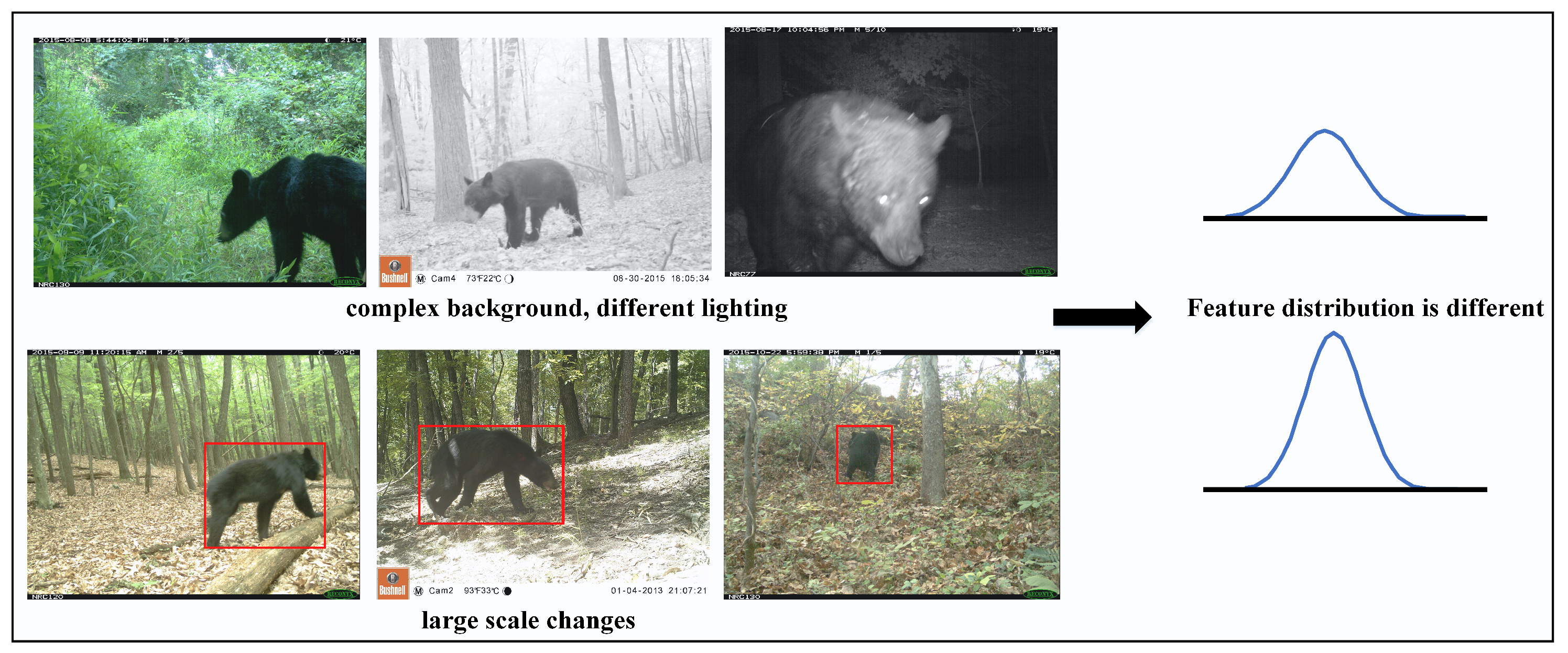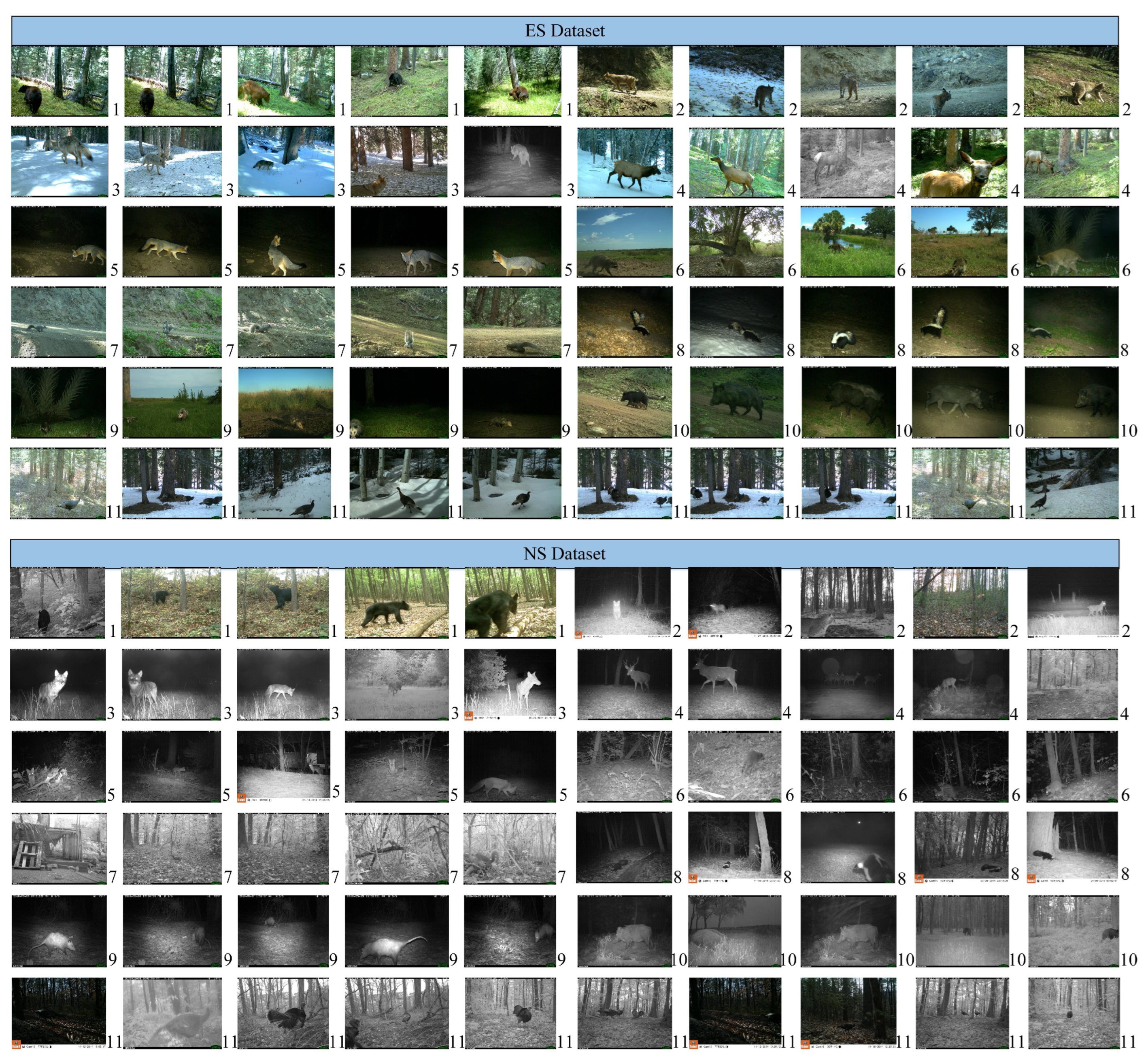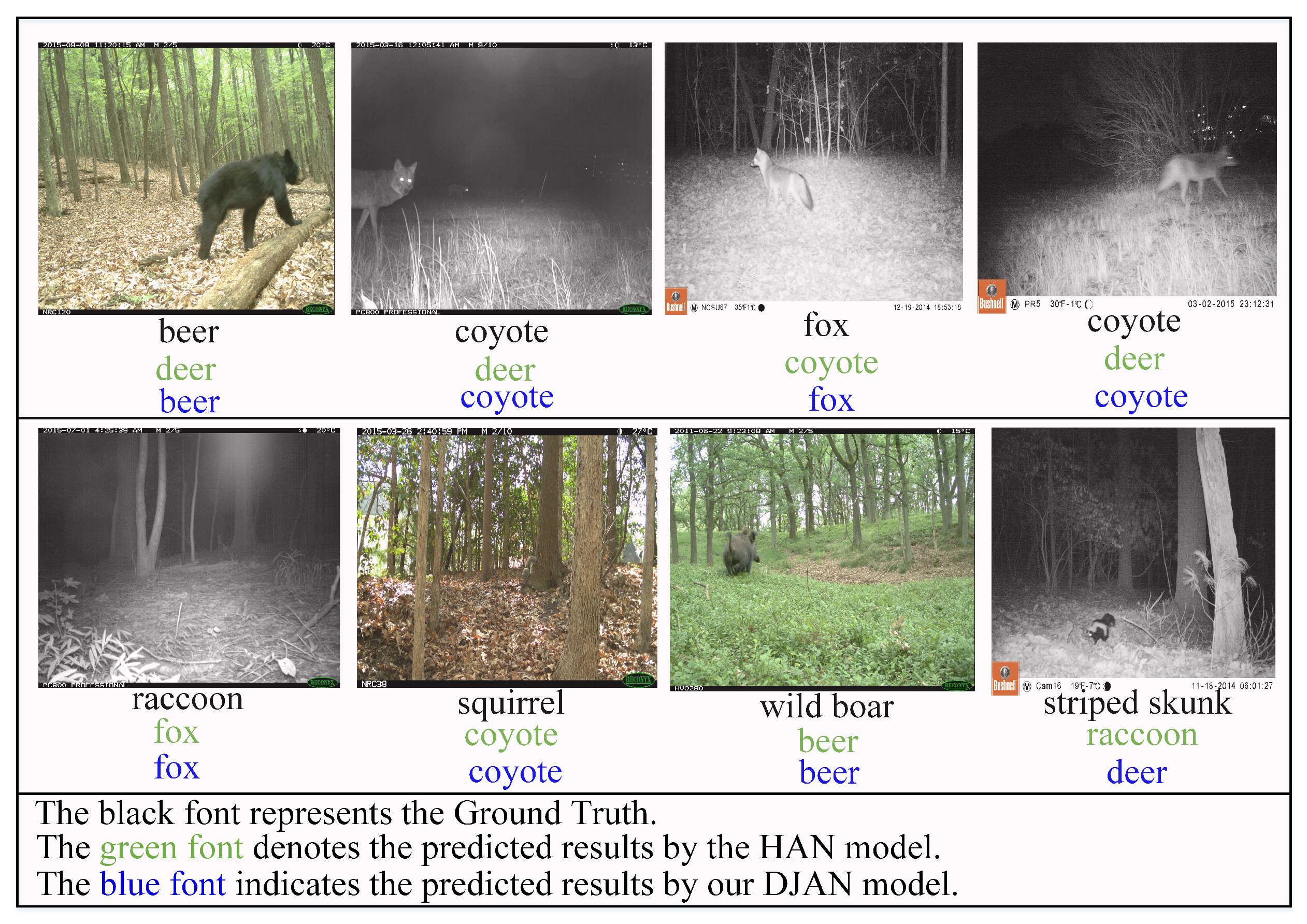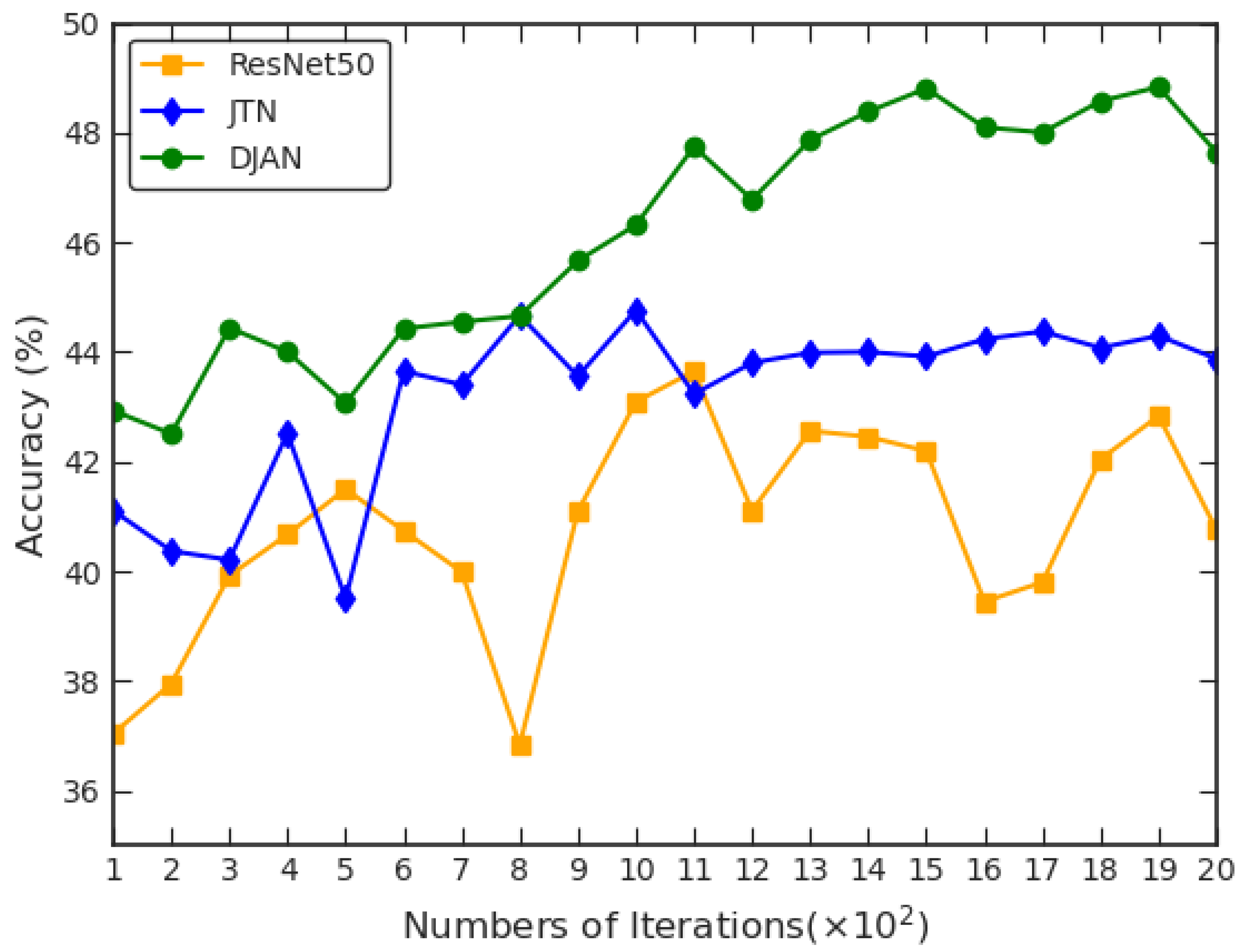1. Introduction
Wildlife identification is a crucial component of monitoring and conserving biodiversity in the wild. Wildlife monitoring serves as the foundation for wildlife conservation management [
1] and plays an importance role in this regard. Through collecting and analyzing data on various aspects of wildlife, such as habitat utilization, migration patterns, quantity distribution, and behavioral activities, monitoring provides valuable information [
2] and insights for conservation organizations and government agencies. These data unveil key issues related to species population status, habitat quality, and habitat connectivity, which, in turn, contribute to the development of effective conservation strategies and management plans. Thus, the identification of wildlife species is essential for species diversity detection and the conservation of rare and endangered wildlife. Currently, camera traps are the mainstream method for wildlife species monitoring [
3,
4,
5]. However, manual identification of monitoring images is known to suffer from the challenges of high intensity and low efficiency. With the rapid development of artificial intelligence technology, automatic wildlife identification methods based on deep networks have demonstrated excellent performance on specific datasets [
6,
7,
8,
9]. A deep convolutional neural network for automatic identification of wildlife was proposed [
10] and achieved a Top-1 accuracy of 88.9% and a Top-5 accuracy of 98.1% on the Serengeti dataset, a public wildlife dataset. Trnovszky et al. [
11] achieved a recognition accuracy of 98.0% using an improved LeNet model on a dataset containing five wildlife species. Verma et al. [
12] addressed the interference of cluttered scene images, which do not contain individual animals, in wildlife recognition in monitoring datasets. They utilized deep convolutional neural networks (DCNNs) to extract features from cluttered scene images and achieved cluttered scene image recognition based on VGGNet and ResNet, further improving the recognition accuracy of high-value wildlife monitoring images. Schneider et al. [
13] focused on the problem of model generalization in unknown scenes and compared the performance of different deep learning methods on various data scenarios. Vargas-Felipe et al. [
14] used convolutional neural networks to recognize wildlife in monitoring images, and their recognition accuracy was significantly better than that of traditional recognition methods. Schindler [
15] combined instance segmentation networks with action recognition networks to detect wildlife and perform simultaneous action recognition, providing more-diversified ecological analysis data for wildlife monitoring. However, in the real world, as depicted in
Figure 1, factors such as different backgrounds, varying lighting conditions, and diverse shooting scales can lead to changes in feature distributions within the same class of images [
16,
17,
18,
19]. These factors can result in suboptimal performance of existing deep learning algorithms, posing significant challenges to image recognition.
With the successful application of deep domain adaptation in various fields such as pattern recognition and computer vision, the learning paradigm based on deep transfer learning updates or ‘transfers’ models from one domain to another, breaking the limitations of traditional deep learning models that require a large amount of labeled data as a prerequisite and also overcoming the strict requirement for data to follow the same distribution. Therefore, domain-adaptation-based wildlife image recognition has become a current research hotspot and has yielded good results. Norouzzadeh et al. [
20] applied transfer learning to pre-trained convolutional neural network models such as AlexNet, NiN, VGGNet, and GoogLeNet, and compared the performance of the two models in automatically detecting animal species in CT image datasets. A transfer-learning-based wildlife image classification method [
21] is proposed that is based on the Xception network, achieving an average accuracy rate of 99.01%, which is a 57.82% improvement in accuracy compared to standard convolutional neural network methods. Thangaraj et al. [
22] utilized the concept of transfer learning fine-tuning and fine-tuned mainstream network models such as DenseNet169 and Xception for animal individual recognition. Compared with other models, the InceptionResNetV2 model achieved an accuracy rate of 94.82%. By employing deep domain adaptation approaches, not only are the limitations of traditional deep learning methods requiring a large amount of labeled samples and samples following the same distribution overcome, but also data-driven optimization of recognition models with strong generalization capability can be achieved. However, the aforementioned models are still limited to optimizing DCNN models for wildlife recognition through transfer learning fine-tuning approaches, and they cannot be widely generalized and applied. The diversity of wildlife species, the similarities between classes, and the differences within classes increase the difficulty of wildlife recognition, requiring the establishment of models with strong feature extraction and generalization capabilities for wildlife recognition.
The above-mentioned transfer learning methods only utilize the idea of fine-tuning, which can partially leverage knowledge from the source domain to assist the learning of the target domain and mitigate domain differences. However, in order to further alleviate domain discrepancies and enhance the model’s generalization performance, some researchers have proposed a series of deep transfer learning methods. Sun et al. [
23] proposed the Correlation Alignment (CORAL) method, which utilizes a linear transformation to align the second-order statistical information between the source domain sample distribution and the target domain sample distribution, aiming to minimize domain differences. However, CORAL relies on linear transformations and cannot be trained in an end-to-end style. To address such a limitation, Sun et al. [
24] further extended the CORAL algorithm and introduced the Deep Correlation Alignment (DCORAL) algorithm. DCORAL embeds CORAL directly into a deep network, constructing a differentiable loss function to minimize cross-domain correlation differences. With the advent of Generative Adversarial Networks (GANs) [
25], adversarial domain adaptation methods [
26,
27,
28,
29,
30] have emerged, which aim to generate domain-transferable features through the adversarial game between a feature generator and a domain classifier. Inspired by the idea of GANs, a domain-adversarial neural network [
31] is proposed, which involves three modules: a shared feature extractor cross-domain, a label classifier, and a domain classifier. The feature extractor and label classifier aim to minimize classification errors in the source domain, ensuring that the learned features are discriminative. At the same time, the domain classifier maximizes the domain classification error, encouraging domain-invariant feature distributions. To balance the competition between the feature extractor and label classifier with the domain classifier during training, a gradient reversal layer (GRL) is introduced. GRL works by reversing the gradients of the domain classifier’s loss so that while the domain classifier aims to minimize its loss, the feature extractor maximizes its loss. This is achieved by flipping the sign of the gradients and propagating them back to the feature extractor. The gradient reversal layer enables the network to ensure domain confusion between the domains while preserving the discriminative power of the learned features.
Based on DANN, Long et al. [
32] presented a joint domain adaptation network model that outperforms domain-adversarial network models on multiple image classification databases. The JDAN model considers how to match the joint activation distributions of multiple layers in the source and target domains by constraining the Joint Maximum Mean Discrepancy (JMMD). It uses a multi-layer neural network to parameterize JMMD and employs adversarial learning methods to learn discriminative features. Chen et al. [
33] discovered that although adversarial domain adaptation methods enhance the transferability of features, they can decrease the discriminability of feature classes. To address this, they introduced batch spectral penalization during training to ensure that the differences between feature values are not too large, thereby preserving feature discriminability. The shared network feature extraction mechanism prevents the generation of domain-specific information for each domain. To overcome this, Tzeng et al. [
34] used a weight non-sharing strategy to independently generate features for each domain. Unlike DANN [
31], this method allows the feature extractor to generate more domain-specific features due to the non-shared parameters. Volpi et al. [
35] utilized a feature generator for data augmentation within the source domain feature space. They employed a domain classifier to distinguish between the generated and authentic features, ultimately aligning the distribution of the augmented data with that of the target domain.
The aforementioned methods that use cross-domain feature alignment based on marginal probability distributions overlook the effect of conditional probability distributions in improving network transfer gain. Therefore, researchers have introduced class information to align the conditional probability distributions cross-domain. A multi-adversarial domain adaptation method is proposed [
36] to capture the multi-modal structure of data. For a K-class classification problem, this method introduces K domain discriminators, where each domain discriminator matches the samples from the source and target domains with the same label. Specifically, it performs soft classification of the data based on probabilities generated by the class classifier. When the label space of the target domain is a subset of the label space of the source domain, i.e., in the case of partial domain adaptation, it needs to select a subset of source domain samples from the shared label space. There are also some methods that, although they do not employ multiple domain discriminators, achieve similar effects by introducing class information and are therefore classified as multi-adversarial methods. A conditional domain adversarial networks is presented [
37], which combines instance weights with adversarial feature learning to capture the multi-modal structure hidden under complex data distributions, leading to effective knowledge transfer. However, during the process of translating technology into practical applications, existing methods have two limitations. Firstly, they rely on single-domain adaptation and class information, neglecting the relationship between adversarial domain adaptation and domain alignment. Secondly, they fail to capture the long-term relationship between local and global feature representations, which would help better understand the overall structure and relationships within images. To address these challenges, a Deep Joint Adaptation Network (DJAN) is proposed in this paper, as shown in
Figure 2. Specifically, it incorporates class information into the domain adversarial network to explore more fine-grained transferable features. Additionally, it further exploits more transferable features across domains via considering correlation alignment. It is worth noting that the domain-transferable features learned in this process exhibit strong transferability for different images and different transfer tasks, demonstrating the generalization capability of this method. It effectively improves the accuracy of wildlife image recognition while enhancing the usability and scalability of the approach. In the learning process, a transformer unit is proposed to capture the long-term relationship between local and global feature representations, achieving optimal transfer effects. In summary, this paper presents three main contributions:
A correlation alignment constraint and the strategy of conditional adversarial training are proposed to enhance the capability of individual domain adaptation modules.
Combining the correlation alignment constraint and the strategy of conditional adversarial training, a transformer unit is proposed to capture the long-range relationships between the local and global feature representations, which facilitates better understanding of the overall structure and relationships within the image.
A series of experimental results prove that our approach yields state-of-the-art results, and, compared to the best results achieved by the baseline methods, the average accuracy of identifying the eleven wildlife species improves by 4.7%.
Figure 2.
Structure diagram of Deep Joint Adaptation Network. Note: denotes the loss function of optimizing the source domain data; is correlation alignment loss, which is defined as the measurement between the second-order statistics information of label classifier prediction of the training and test images; indicates the objective optimization function for the final domain discriminator D and feature extractor G in adversarial domain alignment; represents a transformer loss.
Figure 2.
Structure diagram of Deep Joint Adaptation Network. Note: denotes the loss function of optimizing the source domain data; is correlation alignment loss, which is defined as the measurement between the second-order statistics information of label classifier prediction of the training and test images; indicates the objective optimization function for the final domain discriminator D and feature extractor G in adversarial domain alignment; represents a transformer loss.
4. Discussion
By joining adversarial learning image recognition and vision transformer study research, a Deep Joint Adaptation Network is proposed for a wildlife image recognition model that can both accurately recognition wildlife and enhance generalization ability. Different from domain adaptation wildlife image recognition, such as [
20,
21,
22], the proposed method generates domain-transferable feature representations across domains by the correlation alignment constraint, conditional adversarial training, and cross-domain local and global representation learning method. The correlation alignment constraint and the strategy of conditional adversarial training improve the capability of individual domain adaptation modules. In addition, a transformer unit is utilized to capture the long-range relationships between the local and global feature representations, which facilitates better understanding of the overall structure and relationships within the image. In the study of wildlife image recognition, some deep learning models, such as [
10,
11,
12], also yielded significant recognition results. However, when these methods are confronted with datasets where the feature distribution is significantly affected by factors such as different backgrounds, lighting conditions, and varying scales of capture, the recognition performance can degrade significantly. Moreover, our method avoids the use of costly sample annotation information, which promotes the application of wildlife image recognition in real-world scenarios.
As shown in
Table 3,
Table 4 and
Table 5, it can be observed that conditional adaptation learning and correlation domain alignment obviously further promote the ability of the model to extract more domain-transferable features. This reflects that the combination of the two could further enhance highly transferable feature learning, strengthening the complementarity between adversarial feature learning and domain correlation alignment and thus achieving higher accuracy in wildlife image recognition. However, this mechanism does not consider the long-term relationship between local and global feature representations, which can help to better understand the overall structure and relationships within the image. In this paper, with the help of the domain adaptation strategy of conditional adaptation learning and correlation domain alignment, we designed a transformer loss constraint to capture the long-range relationships between the local and global feature representations, which facilitated better understanding of the overall structure and relationships within the image. With the utilization of the transformer loss to guide the DJAN model learning cross-domain local and global representation, the DJAN model yielded an accuracy of 58.2%, which achieved a 7.9 percentage point improvement in
Accuracy compared to utilizing conditional adaptation learning and the correlation domain alignment constraint.
The proposed method for wildlife recognition in this paper has indeed improved the recognition accuracy. However, there are still instances where certain individual wildlife species are misclassified (as shown in
Figure 5). The main reason for this is the impact of the wildlife photography environment on the transferability of features and the recognition results. Therefore, it is worth considering the introduction of image enhancement algorithms to mitigate the influence of complex background factors and to improve the effectiveness of the model. Furthermore, the next step of this research involves deploying the proposed wildlife recognition model on edge devices to achieve real-time, efficient, and privacy-secure wildlife monitoring at the edge.











